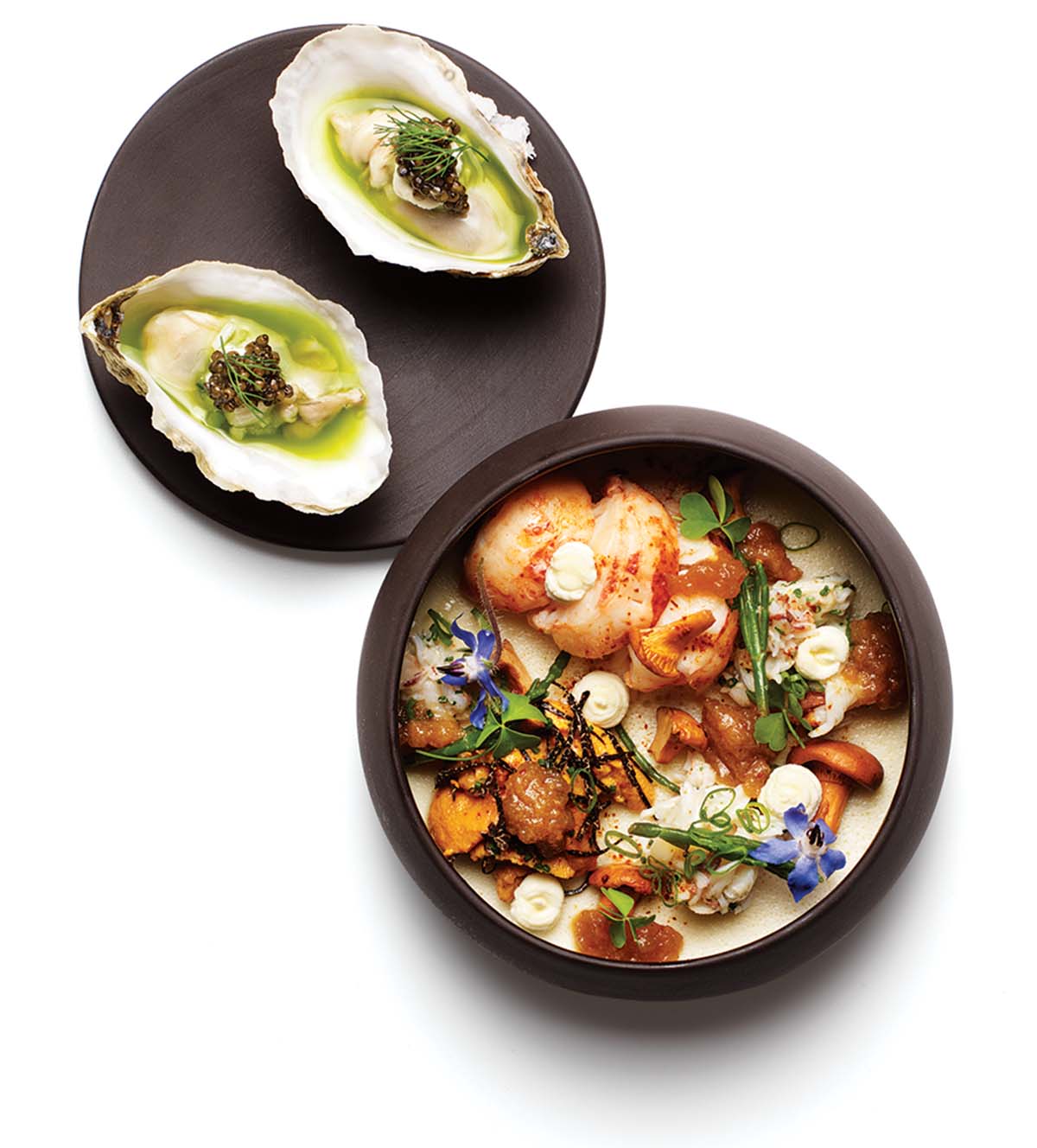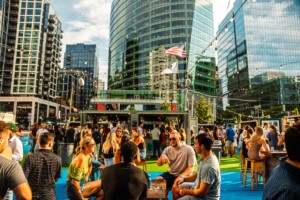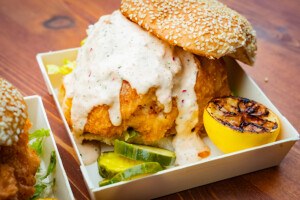What’s for Dinner…Next?

In Campbell’s “assiette of shellfish,” a dish of marinated oysters sits atop a corn panna cotta studded throughout with lobster, sea urchin, and Jonah crab. Presentations are meant to play with diner expectations, while staying in the realm of “real” food. Photograph by Bruce Peterson
“There is a sense that the culinary-science frontier is here in Europe, and not in the U.S.,” Edwards says. Le Laboratoire Cambridge and Café ArtScience, he hopes, will change this perception. “This is not Ferran Adrià done the American way. This is a completely different angle.”
It’s not surprising that Edwards brings up Adrià, chef of the famed El Bulli restaurant in Spain. The style with which he is associated, molecular gastronomy (Adrià dislikes the term), uses colloidal science to transform recognizable ingredients into unrecognizable forms: olive oil “caviar,” gel-based “ravioli,” flavored foams, edible glass. It’s a series of techniques that have become passé because of a plethora of poor imitators. Gastronomes have moved on to fetishizing practices like fermentation and foraging.
Campbell, Café ArtScience’s chef, could not be further removed from the molecular- gastronomy aesthetic. And for his part, Edwards says he’s not attracted to avant-garde, exclusionary haute cuisine. Instead, he wants to find out if changing the way we eat can change the way we live. “Food is the Internet of tomorrow,” he says. “Some of the major problems and opportunities of the planet are related to how we eat.”
When Edwards launched Le Whaf in 2011, star chefs from around the globe—Ben Shewry, from Attica, in Melbourne, Australia; Massimo Bottura, from Osteria Francescana, in Modena, Italy; Homaro Cantu, from the experimental restaurant Moto, in Chicago—flew to Le Laboratoire Paris to create Whafs in flavors like duck à l’orange.
Despite the connections, Edwards has no formal training in food. A biomedical engineer, he holds degrees from Michigan Tech and the Illinois Institute of Technology, and worked as an instructor and researcher at MIT. In 1997 he developed a workable prototype for inhalable insulin and sold the resulting company for $114 million. Later, Edwards went to teach at Harvard, joining the School of Engineering and Applied Sciences in 2002. He became obsessed with the idea of combining the arts and sciences to foster an organic type of innovation, what he calls “blue-sky” ideas, without the constraints of commercial viability or practicality. In 2007, he opened Le Laboratoire in Paris, as a nonprofit incubator.
Here, Edwards’s inventions became ever more absurd and fantastical, the opposite of his early foray into pharmaceuticals— flavored clouds, ice cream bonbons, inhalable energy shots, textable scents—with a promise of someday improving people’s lives, but with a right-now novelty factor that could engage a food-crazed public.
It’s hard not to buy into Edwards’s vision as he outlines it for you—eyes closed, head tilted off into the distance, hands gesturing as if he sees the impact of his products already in his brain and must hold on to it as he speaks. He envisions a world in which Wikis lower carbon footprints; scents can be transmitted as aromatherapy and help with PTSD in war-torn nations; and nutrients can be inhaled on the go via portable tubes.
Frozen-yogurt balls and inhalable powders, however, sound more like spectacles than world-altering technology. But if you ask Edwards, it’s just that these ideas require time to take off. He needs a way to sell them to the public. That’s where Café ArtScience comes in.
“Eating differently will only happen if people actually want to,” he writes to me later in an email. “I have a vision. But people will decide the future of food, and Todd and Patrick will be closer to this future at [Café ArtScience].”
The next morning, we’re weaving down a slim staircase in the back of the Poilâne bakery on the Rue du Cherche-Midi in the 6th Arrondissement. As we approach the production area, we’re smacked in the face by the scent of nutty, warm butter and yeast.
A fire roars in the old-school wood-fired oven, a fire that owner Apollonia Poilâne says has burned since her grandfather opened the business in 1932. She lifts a thick bolt of cloth off the top of a massive mixing bowl, and we inhale the damp, sweet-sour scent of the dough, made with a starter that’s as old as the bakery itself.
Poilâne, 30, met Edwards through Harvard connections, and is interested in collaborating with Café ArtScience. While the bakery produces its bread in a deeply traditional manner, it also practices what Poilâne’s grandfather dubbed “retro-innovation.” Using “the best of past techniques, and the best of future techniques to move forward,” Poilâne says. “That balance is the essence of what we are doing.”
This careful dance between tradition and innovation will be essential for the success of Café ArtScience. That challenge is particularly steep because its forward-looking elements are much more out-there than just advanced baking machinery. Take, for example, Edwards’s latest invention: the oPhone, a device that, when paired with a smartphone, will allow users to transmit scents via text message. Slated to go on sale to the public in 2015, it will be available for diners to try out at Café ArtScience.
The oPhone, in fact, is the reason Edwards isn’t with us at Poilâne. As we inhale the ancient bread starter, he’s on a plane bound for New York. Tomorrow, Tuesday, Le Laboratoire will host the oPhone’s first transatlantic smell transmission, from Paris to Manhattan, then on Thursday, a big party to celebrate.
That’s how I run into Maul, Mastricola, and Campbell working together for the first time: prepping for the party in Edwards’s basement lab, a long room with cabinets containing beakers of all different sizes, a tank of reverse-osmosis water, and blue barrels of lactate calcium and sodium alginate. Rolling racks hold tray after tray of flavor essences: passion fruit, apple, almond, oak, violet blossom, chocolate-mint, lime. There’s an induction range, a blast chiller, a Pacojet for making “micro purées.” Campbell is plucking asparagus buds from their stems to garnish his steak tartare—something that he’s nervous about serving to a crew of Parisians. (“It would be like if the French came over to Boston and served lobster rolls and chowder,” he says.)
Mastricola perches on a stool at a metal table, peeling dozens of oranges for the Tom Collinses Maul will be serving: Instead of the traditional orange-slice-and-cherry garnish, Maul and Mastricola came up with a Wiki that has a “skin” of orange juice and zest, and a cherry-juice center.
Maul, who is also experimenting with an eggnog Wiki, pulls a metal bowl out of the refrigerator that contains a batch of thick eggnog batter. It’s a recipe that he found in an old French New Orleans cookbook and tweaked; his version gained a cult following at Clio. He passes the frothy batter to Marlene Staiger, Edwards’s lab manager, who passes the bowl under her nose and inhales. “Rum and cognac, yes?”
“You’ve got a good nose,” Maul replies.
Campbell asks, “Why not do a lavender-and-honey summer eggnog? Or one with rosemary?”
This kind of collaborative experimentation happens in many restaurant kitchens, of course, but it’s crucial to how Café ArtScience will run. The group plans to hold Sunday meetings devoted to brainstorming. The meetings will start out as staff-only, but then open up to others in the restaurant industry. Eventually, they’ll be open to the public as well.
“It’s built into the DNA of the restaurant. You’re asking people to ask questions,” Maul says later. “It’s part of your job description—to ask questions, and bring an idea to the table.”
At 5 p.m., we gather in Le Laboratoire’s sleek oPhone retail space for the big moment. Shiny and white, the place couldn’t be more different from the Poilâne bakery’s warm glow. Christophe Laudamiel, who holds a degree in chemistry, has taught at MIT, and developed perfumes for the likes of Tom Ford, will be sending a scent to Edwards, stationed at the American Museum of Natural History in Manhattan. Laudamiel is wearing a hot pink button-down with the first two buttons undone, a gold-studded belt, and red sneakers. The words “oPhone: the phone that brings scent to mobile messaging” are circulating around the room on a digital screen in multiple colors. “This is making me dizzy,” Mastricola says.
Cameras from a local news station are set up, and Laudamiel is facing a laptop, where he’ll be corresponding with Edwards. The room goes silent; then the computer rings, and the news cameras train to the screen. Nothing happens. “David has vanished into the oPhone! He got sucked in!” Laudamiel says. They try again, and the call goes through. Laudamiel hits “send.” “We have sent that to someone in the skies! That’s it!”
We wait for confirmation from Edwards that he’s received the transmission, that the scent of passion fruit–chocolate macarons from Pierre Hermé and champagne has wafted electronically to New York. “We got it!” he says, and the room erupts into applause and cheers.
The next evening, the team’s food gets an equally warm reception from the crowd. All of the guests are happily clutching Collins glasses filled with pink-streaked liquid, thanks to Maul’s Wiki garnish. Campbell is stationed in Le Laboratoire’s retail/coffee shop, doling out silver spoons filled with an elegant tableau of tartare, asparagus mousse, lemon rind, and caviar.
Apollonia Poilâne is here, enjoying Campbell’s tartare. Edwards’s wife, Aurélie, returns for a second helping, mouthing, “This is unbelieveable!” as she takes it. Edwards finally tries it. “It’s so delicate,” he says. He’s impressed. Afterward, Edwards admits this is the first time he’s tasted Campbell’s cooking—incredibly, he’s staked the future of his restaurant on a chef whose food he’s never eaten.
After the party, Edwards takes the crew out for a farewell dinner. We head for the restaurant atop the Centre Pompidou. It’s a see-and-be-seen type of place, with servers who look like lingerie models, and exquisite, sweeping views of the Paris skyline. We’re seated at a long table right up against the railing. Edwards points to a member of the French ministry at a nearby table. Over to our right, there’s the director of the Pompidou. “And we have better tables than both of them,” he says.
Everyone is drinking wine, cutting into steaks, and Edwards is explaining Café ArtScience to Jim Buzzitta, an old friend and potential backer who has joined us. “We didn’t want this to be a performance,” Edwards is saying. “We were interested in this way of influencing how we eat. We need to eat for lots of reasons, and there is so much inertia.”
The table falls silent, as we all take in the dusk that’s swathing the city in a golden light. “I’m feeling pretty lucky right now,” Mastricola says quietly. Soon, the skyline fades to black, and the Eiffel Tower, off in the distance, begins its once-nightly glittering light show. Edwards and Buzzitta start spitballing the potential effects of the oPhone—imagine tweeting aromatherapy scents to Honduras, or using it to help people with Alzheimer’s. By the time the check comes, it’s close to midnight. “My body is collapsing,” Edwards says, admitting that he’s slept about 10 hours the entire week. He bids the group adieu.
The night, and the trip, could have ended there. But there’s one more place that Maul, Mastricola, and Campbell want to show me. The whole time they’ve been in Paris, they’ve ended their nights at the same spot: a dingy café across the street from their flat on the Rue Cadet. It’s called Le Regent, but they only know it by the neon sign in the window: Service Non Stop.
This is food service at its most basic, a gathering place where people can show up, feel comfortable, and yell at the World Cup on the television.
We cram into an outdoor table on chairs with battered maroon velvet cushions. Christiane, the feisty server they’ve gotten to know over the course of the week, brings Mastricola and Campbell double gin and sodas, and Maul a Heineken. Mastricola tells me he discovered a giant hair in one of their pizzas earlier in the week. “You always gotta find a local when you go somewhere,” he says. This has become theirs.
Midnight approaches, and it’s Maul’s 46th birthday.
Campbell flicks his Marlboro cigarette onto the pavement, and gestures toward the neon Service Non Stop sign. “It’s our mantra for the restaurant,” he says.
They all know that for Café ArtScience to succeed, it will need more than futuristic dazzle; it will need a little bit of Service Non Stop, a little bit of soul and sass and comfort. They talk about printing up “Service Non Stop” T-shirts, about incorporating the phrase into staff training. Now it’s 2 a.m., and the guys tell Christiane that it’s their last night together in town. She brings over a round of cherry-flavored shots as a thank you for their business. They leave her a giant tip.
Campbell starts brainstorming aloud about Le Whaf—what about a béarnaise sauce infused with tarragon stems, shallots, vinegar, and lots of good butter? The resulting vapor could waft over a steak, perfuming it with an herbal, buttery scent. On this last night in Paris, Campbell says, “Everything is on the table.”


